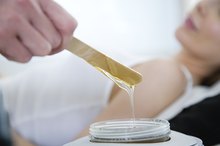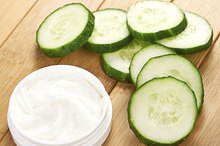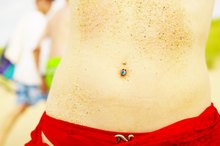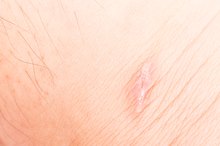How to Reduce a Keloid
A keloid scar is a red, purple or brown raised scar that can result after an injury. While scarring is a biological safety method to protect the skin, a keloid arises when the scar tissue multiplies beyond what is necessary to protect the wound. Keloids can be found on most areas of the body and can occur after injuries, such as piercings, acne, burns or surgery, or even following shaving irritation. Treatments to reduce a keloid range from conservative to surgical 1.
Apply a silicone gel sheet to the keloid on a daily basis. These gel pads work to soften a keloid's scar tissue as well as reduce its size. They can be purchased at most pharmacies.
How to Apply Pressure for Keloid Scars
Learn More
Use a pressure device, such as a compression bandage or earring in order to reduce the keloid's size. Compression helps break up the scar tissue and restore circulation to the area, which reduces the overall appearance. If the keloid is on the ear, wearing an earring-type device that places pressure directly on the keloid can help to reduce its size.
Receive steroid injections to the keloid area from a physician. These injections often are given on a monthly basis and encourage the formation of blood vessels in the keloid area. When blood vessels form, they are able to flatten the keloid, which can reduce its appearance.
How to Get Rid of Stitch Scars on the Face
Learn More
Incorporate more foods that contain vitamin C, such as oranges and lime or lemon juice. Vitamin C stimulates collagen function and encourages tissue growth in the body.
Ask your physician if more invasive means of treating your keloid are necessary. Undergo an invasive treatment option, such as removal surgery, laser therapy, radiation (to reduce size) or cryotherapy to freeze and destroy skin cells. It's important to carefully discuss any invasive options, as there is always a chance for keloid recurrence.
Tips
Because keloids have a tendency to become darker than the surrounding skin, it's a good idea to keep a forming keloid away from the sun, as this can reduce the keloid's dark appearance.
If you have utilized conservative treatments on a six-month basis yet have seen no improvement, ask your physician to evaluate the keloid for other possible treatment options.
Warnings
Keloids often are the result of family history. If you have a history of developing keloids or have a close family member with keloids, you may wish to refrain from keloid-causing activities, such as piercings.
Related Articles
References
- BioSkinRelief.com: Keloid Treatment
- McGinty S, Siddiqui WJ. Keloid. StatPearls [Internet]. Updated March 19, 2019.
- Tsai CH, Ogawa R. Keloid research: current status and future directions. Scars Burn Heal. 2019;5. doi:10.1177/2059513119868659
- Chua SC, Gidaszewski B, Khajehei M. Efficacy of surgical excision and sub-dermal injection of triamcinolone acetonide for treatment of keloid scars after caesarean section: a single blind randomised controlled trial protocol. Trials. 2019;20(1):363. doi:10.1186/s13063-019-3465-6
- Trisliana Perdanasari A, Lazzeri D, Su W, et al. Recent developments in the use of intralesional injections keloid treatment. Arch Plast Surg. 2014;41(6):620-9. doi:10.5999/aps.2014.41.6.620
- Jfri A, Alajmi A. Management of keloid scars: surgical versus medical therapy. J Dermatol Res Ther. 2018;4:059. doi:10.23937/2469-5750/1510059
Resources
Writer Bio
Rachel Nall began writing in 2003. She is a former managing editor for custom health publications, including physician journals. She has written for The Associated Press and "Jezebel," "Charleston," "Chatter" and "Reach" magazines. Nall is currently pursuing her Bachelor of Science in Nursing at the University of Tennessee.









